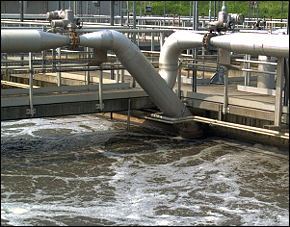U.S. House Appropriations Committee Cuts Funding for Water Programs in 2013 Budget
Funds for water infrastructure are slashed.
By Brett Walton
Circle of Blue
Last week, the House Appropriations Committee, which handles the federal budget process, approved a fiscal year 2013 spending bill with significant cuts for water infrastructure and water quality programs.
Overall spending for the U.S. Environmental Protection Agency (EPA), the Department of the Interior, the U.S. Forest Service, and 20 related agencies is 6 percent lower than President Barack Obama had requested and 4 percent below the fiscal year 2012 budget.
The EPA takes the brunt of the cuts, seeing its funding cut by 17 percent compared to fiscal year 2012.
| Program | Fiscal Year 2012 (in million $US) | FY2013 President’s Proposal | FY2013 House Committee |
| EPA | 8,449 | 8,340 | 7,055 |
| Clean Water State Revolving Fund | 1,466 | 1,175 | 689 |
| Drinking Water State Revolving Fund | 917 | 850 | 829 |
| Geographic Programs (Great Lakes, Chesapeake Bay, etc.) | 409 | 411 | 346 |
| Great Lakes Restoration Initiative | 299 | 300 | 250 |
| Land and Water Conservation Fund | 322 | 450 | 66 |
| U.S. Geological Survey (surveys, investigations, and research) | 1,068 | 1,102 | 967 |
Some EPA programs fared worse than others. Seeing the biggest hit will be the state revolving funds, which provide low-interest loans for drinking water and wastewater projects. These two funds will be cut by $US 865 million, or 36 percent, compared to last year’s budget.
In the budget report, the committee justified the steep reduction by saying that the EPA has yet to transfer some $US 2.4 billion from prior spending bills, and that the states — which manage the funds — have $US 5 billion that they have not yet spent.
Tom Curtis, the deputy executive director of government affairs for the American Water Works Association (AWWA), told Circle of Blue that he did not have any way to independently verify where those figures came from. Some of the money could be from the economic stimulus package, which pumped $US 6 billion into the two programs in 2009.
“Even if that is what it is,” Curtis said, “the expectation that the money is appropriated and then immediately flows to a project is unrealistic. The programs were not designed to work that way.”
Curtis called the cuts to the state revolving funds “outrageous,” especially when much of the water infrastructure in the U.S. is in dire need of repair and replacement.
The committee, on the other hand, has said that continuing to allocate money to the revolving funds through the appropriation process is “simply unsustainable given ever-growing needs.” It will instead look for other ways to provide long-term support.
A few programs saw a funding increase. The committee reinstated funds for research on small drinking water systems and supported a request for research into combined sewer overflows. More federal dollars will be spent on water quality in Puget Sound, but similar programs for the Great Lakes and the Chesapeake Bay will be reduced.
The bill now goes to the full House for a vote.
Brett writes about agriculture, energy, infrastructure, and the politics and economics of water in the United States. He also writes the Federal Water Tap, Circle of Blue’s weekly digest of U.S. government water news. He is the winner of two Society of Environmental Journalists reporting awards, one of the top honors in American environmental journalism: first place for explanatory reporting for a series on septic system pollution in the United States(2016) and third place for beat reporting in a small market (2014). He received the Sierra Club’s Distinguished Service Award in 2018. Brett lives in Seattle, where he hikes the mountains and bakes pies. Contact Brett Walton










Leave a Reply
Want to join the discussion?Feel free to contribute!